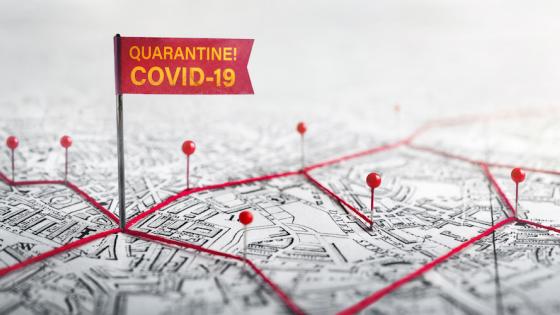Authors' note: Since publishing our column on 8 April, France and Spain have introduced green zones to exit the lockdown. France has opted to delimit the nation into its 101 départements. The French Prime Minister Edouard Philippe announced on 28 April: A département is labelled green if the virus is under control, otherwise it is labelled red. Inter-departmental travel to and from red zones is limited to imperative professional or personal reasons, to limit the circulation of the virus and allow to reopen economic and social activity. On the same day, the Spanish Prime Minister Pedro Sánchez announced a mirroring strategy, delimiting Spain into its 59 provinces and islands. In a subsequent column, we proposed to elevate this approach to the European level.
The Covid-19 pandemic has put the world to the test, and a wide range of social distancing and confinement measures have been implemented globally to reduce the spread of the virus. These severe lockdown measures have brought social and economic activity to an unprecedented halt (Baldwin and Weder di Mauro 2020).
Never before have we been so aware of the many ways we come into contact with innumerable others. We have been forced to reassess and retrain common habits, from handshakes to the simple act of opening a door. This is because the virus spreads via physical proximity: direct contact between people (handshakes, kisses, and hugs), coughs, or even touching objects with contaminated droplets. The sum of all of these contacts forms a large and dynamic physical proximity network – just like Facebook maps out our social interactions online. Disconnecting or weakening this extensive network is the key purpose of the social distancing measures currently in place across the world.
How we come out of lockdown is the next challenge. It is important to avoid a resurgence of the virus while minimising the societal and economic damage. Proposals range from creating herd immunity (Akira Toda 2020), to allowing low-risk groups to return to normality (Ichino et al. 2020), to keeping many of the current measures intact until the development of a treatment or vaccination (Kissler et al. 2020). We propose an exit strategy that mitigates the health risks of the former and the social and economic risks of the latter. This is in line and can be duly combined with other proposals such as keeping limitations in place only for high-risk groups.
Our proposal (Oliu-Barton et al. 2020) is based on two key elements: first, identifying green zones, meaning areas where a public health system is operational, the reproduction rate of infected individuals is low and the future risks appear manageable; second, progressively joining these green zones together once it is safe to do so.
Zoning
Partitioning the world population into disconnected groups, in terms of physical proximity, is the key purpose of lockdowns. Most countries have closed their borders (Wells et al. 2020). However, these measures are ineffectively mirrored in the interior of most countries.
In France, for example, people are asked to stay within 1km of their homes. Although such a measure significantly slows down the spread, the virus can still travel through the entire network. Instead of enforcing a radius of movement for each individual, we propose that it would work better if people were allowed to move within disconnected areas, such as counties, towns, or boroughs. In technical terms, we propose to cut the physical proximity network into disconnected components rather than reducing the number of links without taking the network structure into account.
Clearly, such a division would never be perfect, and it would be easier to enforce between separate towns than between areas of a single town. Thus, while division between some zones could be legally enforced, divisions between other zones would remain a mere recommendation. Such zoning measures – also known as a cordon sanitaire – have been successfully implemented in several areas in China, notably Wuhan, and in India. The zoning would reduce links between different areas and prevent the virus from travelling throughout the territory.
Exit strategy: Green zoning
We propose that each nation should be partitioned into geographic areas, or cells, with 5,000 to 100,000 inhabitants. To limit economic damage, this partition should consider local labour markets, or ‘commuting zones’ – that is, zones which share many economic ties (Tolbert and Sizer 1996, Davis et al. 2019, Monràs 2020).
Each cell is labelled red or green depending on their current Covid-19 status. Red cells correspond to areas where the virus is currently not under control, while green cells are, as described previously, areas where the public health system is operational, the reproductive rate of infections is low, and the future risks appear manageable. The exact condition under which a zone is labelled green needs to be defined with the consultation of medical, epidemiological, and economic experts. In fact, a more cautious terminology, such as ‘amber’, may be preferable in order to communicate the gravity of the situation and the fact that many health measures would remain in place.
In red cells, the situation would be similar to lockdown. The health measures – restrictions on the opening of shops and restrictions on leaving your house – would remain in place. In addition, in order to leave one’s cell, a special certificate would be required. This would be reserved for key workers and travellers with other important reasons. In contrast, life would go back to normal within green cells, as these cells would be progressively joined together to define a ‘green zone’.
Consider a town with some 10,000 inhabitants, where most people work in a local factory or in other occupations within the community. Once the virus is under control (according to a definition as discussed above), the town would be labelled ‘green’. Its inhabitants would then be able to return to their usual social and economic interactions within their zone, but travel out of town would be restricted.
When the virus is under control for approximately a week within a small number of neighbouring green cells, they would be joined together into a green zone. In this way, ever-larger green zones would be created, with people sharing the same shops, workplaces, parks, and schools. On the other hand, if the resurgence of the virus would lead to the loss of control within a green cell, it would be labelled red again and the joining process would be reversed (see Figure 1).
Figure 1 Red zoning and green zoning
Red zoning: The 4x4 green zone ceases to be green because a resurgence of the virus is identified in several cells (step 1 and 2). The zoning is revised to contain the virus (step 3).
Green zoning: After the virus is again under control each cell regains the green label (step 1). After seven days, the green cells merge to form larger green zones (step 2). After seven more days, the green zones merge into yet a larger green zone (step 3).
If, hypothetically, a green zone were to remain green indefinitely, the simultaneous merging of zones would lead to an exponentially decreasing number of zones. Suppose, for example, that a country is split into 4,000 initial zones and in each step of reunification four smaller units are rejoined. In as few as seven rounds of reunification, the whole country would become one single green zone.
Advantages of green zoning
Zoning would of course not be perfect, as testing is limited and imperfect and zoning itself will not be impermeable. Some green zones would therefore inevitably show a resurgence of infections and so cease to be ‘green’. When this happens, the green labelling of the entire area would be lost and we would go back to the previous lockdown situation in some cells. Consequently, while the size of the green zones often increases, it might also decrease from time to time.
To test the impact on the speed of reunification we performed simulations in Oliu-Barton et al. (2020). The results suggest that when the reproductive rate of the virus is controlled, this process would still enable an exponentially fast return to normality. A country such as France, Spain, or the UK, albeit initially partitioned into a couple thousand initial cells, could be reunified within three to six months. This prediction assumes that sufficient sanitary measures are maintained and testing becomes more widely available. For comparison, if we make the unrealistic assumption that the green labels are not lost once gained, the country would need two months before it can be safely reunified.
A safe and efficient exit from Covid-19
In summary, green zoning would allow rapid reunification and the minimisation of societal and economic damage by allowing local labour markets to reopen soon without risking a renewed country-wide lockdown. There would also be the possibility of adopting green zoning to fit each region’s capability to implement other measures, such as the availability of testing, immunity certificates, or the population’s practice of sanitary precautions.
To reap the full advantages that green zoning offers, important policy choices must be made. The definition of zones needs careful consideration of social and economic ties. The rules applying for each zone would need to be clearly defined with consultation of sanitary and medical authorities.
The time has come to consider an exit strategy. Our study suggests that green zoning could complement measures that are already in place. Through the progressive enlargement of green zones, we would be able to rebuild our social and economic interaction in a safe, efficient, and rapid way.
References
Akira Toda, A (2020), “Early draconian social distancing may be suboptimal for fighting the COVID-19 epidemic”, VoxEU.org, 21 April.
Baldwin, R and B Weder di Mauro (2020), “Economics in the Time of COVID-19”, VoxEU.org, 6 March.
Davis, D R, J I Dingel, J Monràs and E Morales (2019), “How segregated is urban consumption?”, Journal of Political Economy 4: 1684–1738.
Ichino, A, G Calzolari, A Mattozzi, A Rustichini, G Zanella and M Anelli (2020), “Transition steps to stop COVID-19 without killing the world economy”, VoxEU.org, 25 March.
Kissler S M, C Tedijanto, E Goldstein, Y H Grad, M Lipsitch (2020), “Projecting the transmission dynamics of SARS-CoV-2 through the postpandemic period”, Science, published online, 14 April.
Monràs J (2020), “Some thoughts on COVID-19 from a labour mobility perspective: From ‘red-zoning’ to ‘green-zoning’”, VoxEU.org, 25 March.
Oliu-Barton, M, B S R Pradelski, L Attia (2020), “Exit strategy: from self-confinement to green zones”, Esade – Center for Economic Policy & Political Economy, Policy insight No. 6, April.
Tolbert, C M and M Sizer (1996), “US commuting zones and labor market areas: A 1990 update.” Technical report.
Wells, C R, P Sah, S M Moghadas, A Pandey, A Shoukat, Y Wang, Z Wang, L A Meyers, B H Singer and A P Galvani (2020), “Impact of international travel and border control measures on the global spread of the novel 2019 coronavirus outbreak”, PNAS, 13, 7504–7509.





